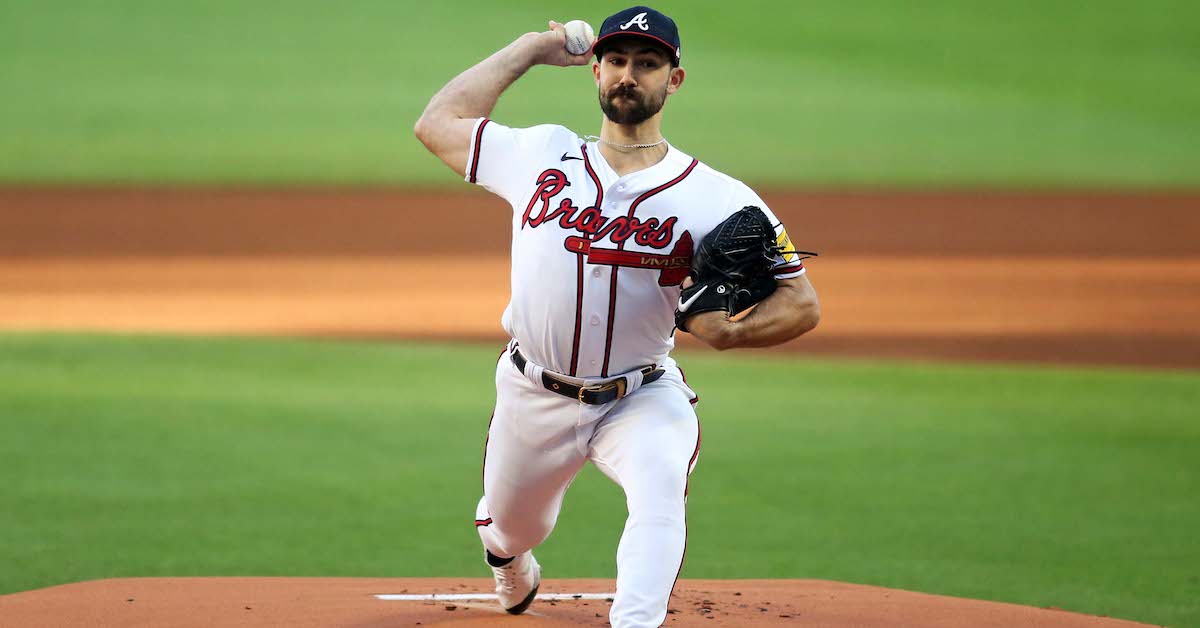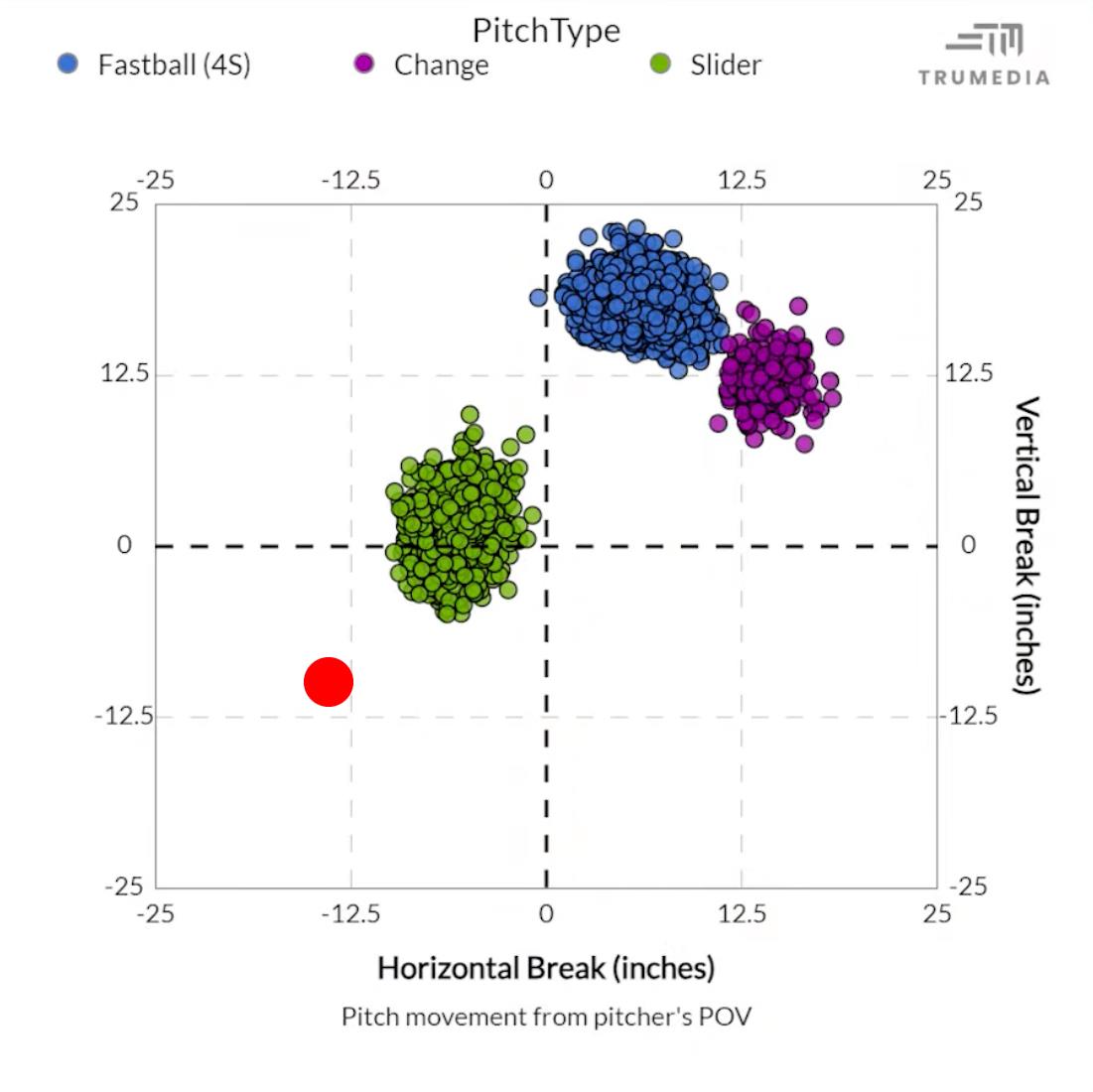
Brett Davis-USA TODAY Sports
It’s almost March! It’s time for the weather to feel like it should be changing, only for it to not really change for a couple more weeks. It’s time for the very first baseball of the year. It’s time for massive overreactions to the tiniest sample sizes imaginable. With that in mind, sound the alarm: Spencer Strider threw three curveballs! “What’s that,” you say? “Spencer Strider doesn’t throw a curveball,” you say? Welcome to 2024, my friend, where anything is possible (except for opaque pants, apparently).
Earlier this month, there was some confusion about the pitch, as Strider indicated that he was simply playing with the shape of his slider. However, since then, both he and Brian Snitker have confirmed that the pitch is a curveball. He’s thrown it in live batting practice and in Saturday’s spring training game against the Rays. It’s the second pitch in the video below:
In the press and on social media, the most frequent reaction to this news has gone something like: Spencer Strider is maybe the best pitcher in baseball with two pitches, so the league won’t stand a chance if he finds a third. However, I wanted to think this through before I signed on to that line of thinking. Simply adding a new pitch doesn’t necessarily make a pitcher better. Last year, I broke down 25 pitchers who’d added a new cutter in 2023. I found that overall, those pitchers performed roughly the same as they had in 2022. Besides, Strider’s four-seamer and slider are two of the nastiest pitches in all of baseball. The slider racked up 306 whiffs in 2023, the most in baseball. The four-seamer racked up 285, second most in baseball. The two obviously play off each other well already. Improving on Strider’s current pitch mix is an extremely tall order.
On the other hand, both Strider’s ERA and FIP increased by just over a run in 2023, and his xERA and xFIP increased by a more than half a run. His velocity also ticked down some, and his groundball rate fell from the 34th to 13th percentile. Strider throws his four-seamer nearly 60% of the time, and while it’s absolutely one of the game’s best, the league as a whole fared better against four-seamers in 2023. All of this is to say that there is room for improvement.
Let’s start with the obvious: We don’t know whether Strider will actually bring this pitch into the regular season. If he does, we don’t know whether he’ll stick with it or whether he’ll use it often enough to make any difference. But the point of this article is to speculate, so let’s talk about how Strider might use a curveball, and why a curveball might help him.
How would Strider use a curveball? He’d definitely use it against lefties to help mitigate his platoon splits. In fact, all three of his curveballs came against lefties on Saturday, and the video of a curveball from live batting practice also came against lefty Matt Olson. Strider used his changeup almost exclusively against lefties in 2023, throwing it 12.5% of the time. In fact, by both wOBA and Baseball Savant’s Run Value, the changeup was Strider’s best pitch against lefties. That’s despite the fact that the changeup rated only an 85 from Stuff+ and a 44 from PitchingBot. As Pitcher List’s Nate Schwartz noted a few weeks ago, by having a pitch that he could locate low and away, Strider forced lefties to worry about all quadrants of the strike zone. Even if it wasn’t the best pitch in the world on its own merit, using it as a change of pace and a change of place from the fastball and slider made it work.
Spencer Strider’s Pitch Mix Against Lefties
| Pitch |
Pitch% |
wOBA |
RV |
RV/100 |
LA |
HH% |
| Four-Seamer |
59.7 |
.318 |
-0.6 |
-0.1 |
16.2 |
36.6 |
| Slider |
27.7 |
.282 |
1 |
0.2 |
24.6 |
53.8 |
| Changeup |
12.5 |
.190 |
1.4 |
0.6 |
8.2 |
6.7 |
SOURCE: Baseball Savant
That’s not the reason I want to talk about the changeup, though. More important for our purposes is the way Strider’s pitch mix changed to accommodate it. That 12.5% came entirely out of the slider column. Despite the fact that he was using three pitches instead of two, his four-seamer rate was actually higher to lefties than it was to righties. Further, Strider almost never threw the change when he was behind in the count, essentially turning back into a two-pitch pitcher. I have to imagine that fact made it into scouting reports, and that batters who already had the advantage of being ahead in the count appreciated having the further advantage of having fewer pitches to watch out for. If Strider ends up trusting the curveball enough to use it a little less surgically, and if he allows it to take some pressure off of the four-seamer, left-handed batters will have a lot more to worry about.
I’m also open to the possibility that a curveball — at least the one that we’ve seen Strider throw — could have a place against righties as well. That has less to do with Strider’s pitch mix and more to do with its movement profile. Let’s start here. In 2023, curveballs from right-handed pitchers to left-handed hitters were more effective than sliders. They earned fewer whiffs, but made up for it by inducing more groundballs.
Sliders and Curves From RHP to LHB (2023)
| Pitch |
wOBA |
EV |
Whiff% |
LA |
HH% |
Barrel% |
GB% |
| Slider |
.307 |
88.5 |
31 |
16.8 |
38.3 |
9 |
36.9 |
| Curveball |
.288 |
88.4 |
30.5 |
10.3 |
38 |
8.3 |
45 |
SOURCE: Baseball Savant
Inducing more groundballs would certainly help Strider. The biggest difference between his 2022 and 2023 stats was he allowed more home runs. Some of that was due to a HR/FB rate that nearly doubled, which usually indicates bad luck. However, according to Baseball Savant, Strider’s expected home runs went from 7.9 in to 22.5. It’s not just that he was unlucky. Strider’s groundball rate fell by roughly six percentage points, and his barrel rate rose despite the fact that his hard-hit rate fell slightly.
Although Saturday’s game not was not recorded by Statcast, professional smart pitching person Lance Brozdowski published its movement profile: “The shape averaged out to -9” vertical break with 14” sweep at 80 mph. It had more sweep than the average right-handed curveball with comparable drop. It’s similar to Jameson Taillon’s or Bryce Miller’s curveball, but more sweep. Both those pitches come in around 110 FanGraphs Stuff+, so I’d expect it to be a notch higher.”
Strider’s changeup and slider don’t have elite stuff on their own. They play well off the four-seamer. In fact, from 2022 to 2023, PitchingBot saw the slider drop from 58 to 51, and Stuff+ saw it drop from 115 to 105. The curveball might well be an improvement in terms of overall stuff. Now, let’s plop that onto a chart of Strider’s pitch movement from last year, because it looks like the curve could open up all kinds of possibilities:

I’m sure you already know that in addition to blistering speed, Strider’s four-seamer has elite rise. What you might not have realized is that his changeup was also among the league leaders in rise, and that even his slider averaged 1.3 inches of rise. In terms of movement, there’s not much difference between his four-seamer and his changeup, which helps to explain why he doesn’t lean on the changeup very much.
And four-seam fastballs, even the ones that rack up lots of whiffs at and above the top of the zone, have a weak point: home runs. When pitchers elevate the ball, hitters have a chance to do the same. Not only does that red dot have more sweep than Strider’s slider, it would be the only pitch he throws with an induced vertical break that doesn’t have a minus sign in front of it. You know all those hitters who prepare to face Strider’s gravity-defying fastball by practicing swinging above where their eyes are telling them that pitch will come in? All of a sudden, they’d have to contemplate the possibility that his pitches could really and truly fall off the table. Even if the curve isn’t as effective against right-handers, it seems like having to worry about that could absolutely benefit Strider’s other offerings. Anything that keeps them from getting on top of his four-seamer and slider would be a win.
Once again, all of this is speculative. We don’t know whether Strider will stick with the curveball. We don’t know whether the shape we’ve seen so far will hold. Maybe he’ll come out and throw a splitter or a sinker in his next start. For now, though, just the idea that Spencer Strider is tinkering with a curveball and managed to throw a good one a few times really is reason enough to get excited.
Many thanks to our own professional smart pitching person, Kyle Kishimoto, who made this article much better.
Source
https://blogs.fangraphs.com/lets-get-excited-about-spencer-striders-curveball/
 Backyard GrillingWeekend WarriorsAdvice from DadBeard GroomingTV Shows for Guys4x4 Off-Road CarsMens FashionSports NewsAncient Archeology World NewsPrivacy PolicyTerms And Conditions
Backyard GrillingWeekend WarriorsAdvice from DadBeard GroomingTV Shows for Guys4x4 Off-Road CarsMens FashionSports NewsAncient Archeology World NewsPrivacy PolicyTerms And Conditions
